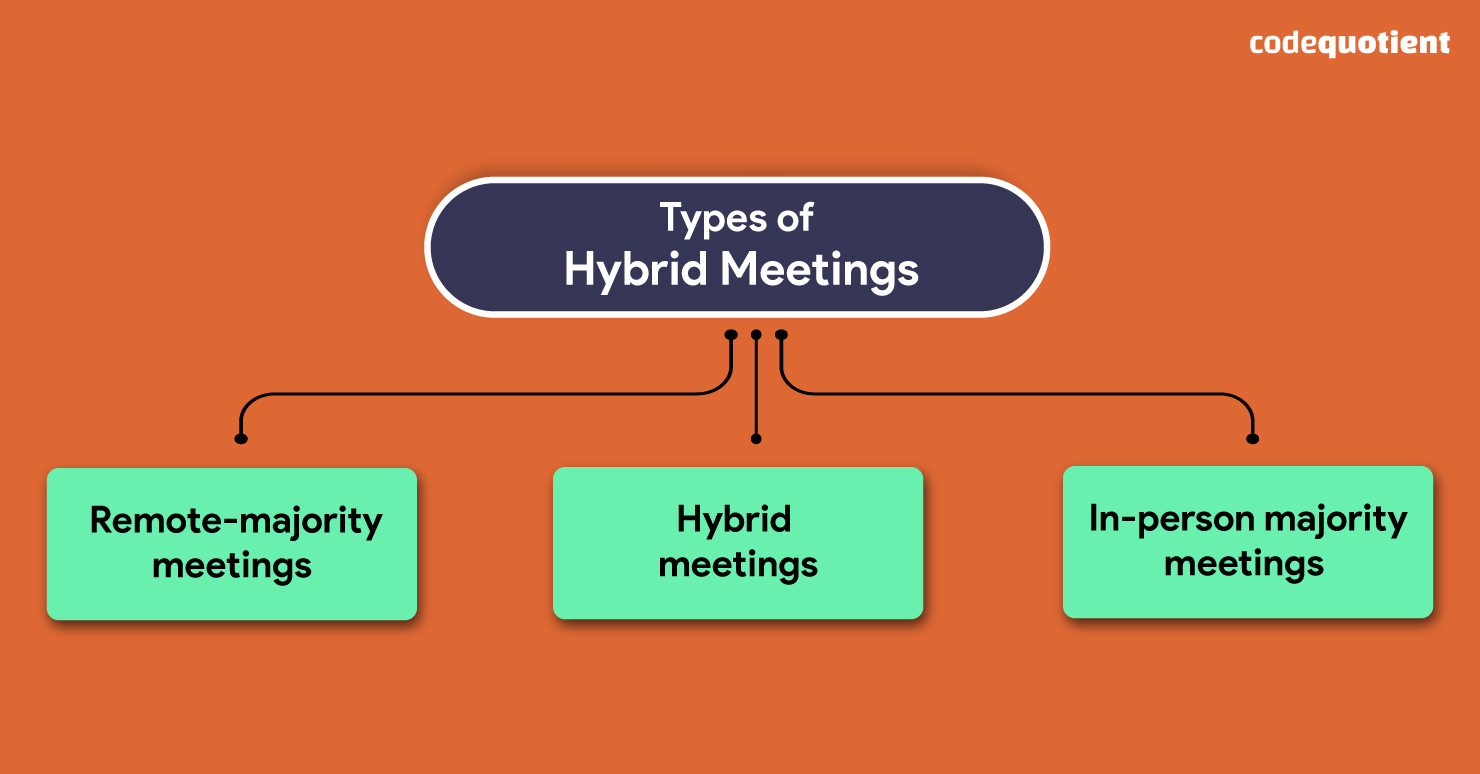The scope and importance of the hybrid work model are growing companies as they seek to adapt and capitalise on the global hybrid trend. Company meetings are not exempt from this movement.
A survey tells us that 76% of respondents reported that their companies have shifted to a hybrid work model. This outcome is reflected in the growth of videoconference traffic which has seen a 535% rise since 2020.
Fortunately, when appropriately managed, hybrid meetings can provide many of the benefits of in-person meetings while also leveraging the benefits of remote collaboration.
So it’s no surprise that hybrid meetings have grown in popularity: they result in more cost-effective, global, and inclusive collaboration between stakeholders.
As seniors responsible for managing remote teaching teams, learn why you must schedule these three types of meetings from time to time.
What are Hybrid Meetings?
A hybrid meeting is a gathering that is open to both in-person and remote tech teams. While it may be preferable to have all attendees in the same room when conducting a class, seminar, group meeting, or another gathering, a hybrid meeting allows attendees to participate remotely if they cannot attend in person.
Having the option for your tech team to participate in meeting remotely is advantageous because it broadens your audience beyond those who can attend in person.
Offering online viewing options removes barriers for anyone hesitant to meet in person, lives in a different area, or simply cannot participate in the in-person meeting.
Different Types of Hybrid Meetings

There usually are three types of hybrid meetings which you can consider for your remote tech teams. They are:
1. In-person majority meetings (Physical meetings)
Things move much more quickly in such meetings. Attendees subconsciously use body language as a social cue to indicate when they are about to start and finish speaking and are willing to give the floor to another participant.
Face-to-face meetings help to strengthen existing social bonds and relationships. An in-person meeting also demonstrates that you value your client’s time and business by making time in your schedule for them. This avoids stop-start conversations and ensures that everyone is heard appropriately.
Pros:
- Builds trust
- More attentive employees
- Fewer interruptions
- Clearer communication
Cons:
- Not suitable for employees in distant locations
- It takes up a lot of time
2. Remote-majority meetings (Virtual meetings)
During the initial COVID-19 lockdowns, virtual meetings became the norm for employees and businesses worldwide. For instance, 200 million people were using Zoom alone every day at the start of 2020–up from 10 million in December 2019.
Virtual meetings are still considered inferior to in-person meetings despite becoming more common. Nevertheless, hybrid and remote forms of work are here to stay, and businesses must embrace them and figure out how to make the most of them.
Pros:
- Meetings can be recorded
- Less small talks
- Enhanced collaboration
- Sharing of files and documents made simple during a presentation
Cons:
- Interaction among employees becomes difficult
- Visual and audio-only
- Less dynamic
- Internet connections can be troublesome
- Different time zones
3. Hybrid meetings
These meetings are the result of combining remote and in-person meeting formats. As the world returns to normal, you will most likely see and use such meetings more frequently as your company and team adjust to regular procedures.
Participants will attend this type of meeting either in person or via a remote communication tool. If your team comprises both on-site and remote employees, this type of meeting may be the best option.
Pros:
- It saves time for both employees and employers
- Cost-effective
- Higher engagement with employees
- Social distancing is easier to manage
Cons:
- You will need more space than usual to keep social distance.
- Engaging both in-person and remote employees needs planning and investment.
How to Effectively Manage Hybrid Tech Teams?
Hybrid teams will fail without the proper resources, technology, and support. Here are some pointers on how to effectively manage your hybrid tech teams:
Establishing a set of unifying rules
The first step in successfully managing hybrid teams is to develop unifying rules that apply equally to on-site and off-site employees. This will help the workforce feel more like a cohesive unit and provide the consistency required of a well-managed team.
With a remote-first approach, where most communications occur online to include all workers, employees must clearly understand how and when to communicate and collaborate with colleagues who are not always physically present.
Some examples of on-point communication are:
- Establishing clear communication channels for contacting team leaders.
- Establishing rules for when employees can begin and end their day.
- If flexibility is provided, define the times that employees are expected to respond.
Setting individual team goals
Setting clear goals is one of the best ways to keep employees on task, whether they work on-site or remotely. More specifically, there should be a mix of collective goals that advance the businesses’ objectives and individual goals that aid in personal development. These objectives must also be SMART, which stands for:
- Specific
- Measurable
- Achievable
- Realistic
- Time Sensitive
Without the physical presence, such goals can provide hybrid employees with a sense of purpose and a clear focus.
Use of multiple communication channels
Since hybrid teams rely heavily on video conferencing software for optimal remote collaboration, platforms like Zoom and Microsoft Teams are likely to play an important role. However, employees should have access to additional communication channels than the mainstream.
Depending on the nature of the business, this could imply providing company phones, setting up an internal messaging system with dedicated channels, email, or all of the above.
However, as previously stated, managers must clearly outline the rules and protocol for:
- When and how to use each channel to avoid losing important information in casual chats or,
- Which channels should be reserved for important information and casual conversation.
Providing better flexibility
The demand for greater flexibility of employees has likely been the most influential factor influencing the rise of the hybrid work model. As a result, the internet is flooded with information about the benefits of flexible work schedules and their ability to boost employee morale.
While the hybrid work model responds to this call by allowing employees to work from home, there is still room for greater flexibility. Flextime arrangements, for example, allow people to choose when they begin working rather than being bound by a 9 to 5 schedule.
Similarly, you might want to think about allowing employees to work compressed work-weeks or other types of flexible work arrangements, depending on your org.
Although hybrid team management differs from traditional management, many of the same principles apply. For example, effective management has always relied on effective communication; the only difference in hybrid teams is that communication has moved online.
For more high-quality information on everything hiring, HR and tech, please bookmark the CodeQuotient blog on your browser and visit the site regularly for new stories.




